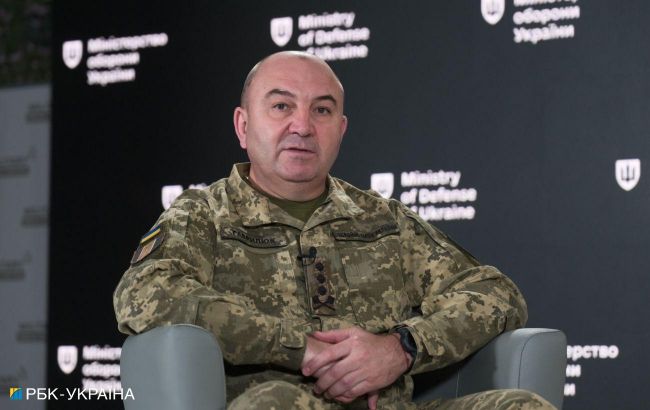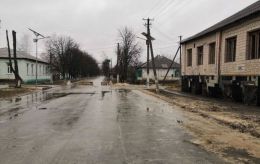General Havryliuk: 'There is no better-prepared army in Europe now than the Ukrainian'
 First Deputy Minister of Defense Ivan Havryliuk (All photos: RBC-Ukraine/Vitalii Nosach)
First Deputy Minister of Defense Ivan Havryliuk (All photos: RBC-Ukraine/Vitalii Nosach)
People and weapons are the key components of war, says First Deputy Minister of Defense, Lieutenant General Ivan Havryliuk. According to him, Russia has a numerical advantage in both. However, in certain areas, Ukraine is already managing to narrow the gap.
In a brief interview with RBC-Ukraine, Havryliuk discussed Ukrainian production of ammunition, drones, and long-range weapons, as well as the comparison of resources between Russia and Ukraine in the war.
Ammunition supply
According to General Havryliuk, the supply of ammunition and all means of destruction to the Defense Forces currently comes from three sources. The first is the domestic production of weapons and ammunition. The second is procurement from imports of items not produced in Ukraine or produced in insufficient quantities. The third source is receiving material-military aid from partners.
He explained that the army's supply of ammunition has improved, and the gap with Russia has somewhat decreased.
"The supply of ammunition can be evaluated as follows. For example, if we talk about artillery ammunition, at the beginning of the year, the ratio of shots between Ukrainian and occupying forces was 1 to 7, 1 to 8, or even more in some months. By early summer, this ratio was 1 to 3. Now, it's approximately 1 to 2," explained the First Deputy Minister of Defense.
He added that the Russians essentially have no limitations in terms of shells. However, Western systems are more accurate and have a longer range. Because of this, Ukraine destroys targets while using fewer shells.

Havryliuk also clarified that today Ukraine’s defense industry produces almost the entire range of ammunition used by the Defense Forces, although not all types are produced in sufficient quantities.
He noted that significant assistance comes to Ukraine under the Czech initiative, which provides NATO-standard 155mm shells. However, the Czech government is also supplying ammunition of other calibers for the Defense Forces.
Ukrainian arms production
The Ministry of Defense says that Ukraine is working on many long-range weapons developments, most of which have been successful. This includes missiles of various types and drones.
"Our production has made a significant step in the development of unmanned systems, particularly in aviation, both short- and long-range," said the general. He added that there has also been significant progress this year in the development of ground robotic complexes and naval systems.
In total, over 900 new types of weapons and military equipment have been codified and approved for use by the Defense Forces in the past nine months. Since February 2022, more than 200 domestic unmanned aerial systems (UAS) of various types and purposes, as well as over 40 ground robotic complexes (GRC), have been approved for supply to the military. Most of these approvals occurred in 2024. In the first nine months of this year alone, 140 UAS and 33 GRC were approved for use.
Former Minister of Strategic Industries, Oleksandr Kamyshin, stated at the end of last year that in 2024 Ukraine plans to produce one million FPV drones, over 10,000 medium-range strike drones, and more than a thousand drones with a range of over 1,000 kilometers. Commenting on this statement, Havryliuk mentioned that almost all of these targets have already been exceeded.
He noted that these achievements are happening despite Russia's ongoing attacks on Ukraine’s economy and enterprises, which have been ongoing for more than two years and eight months. In September, there wasn't a single night without Shahed drone attacks. On average, the enemy launched 44 Shaheds daily to strike Ukrainian territory.
Havryliuk emphasized that North Korea and Iran are helping Russia sustain this tempo of shelling and overall combat actions by supplying not only unmanned systems but also ballistic missiles and artillery ammunition.
Current war - war of drones?
Technology is changing the course of the war, says the First Deputy Minister of Defense. Technological superiority offers a real chance to shift the situation on the front lines in our favor. The role of drones in warfare will continue to grow. However, they cannot yet replace missile forces and artillery, noted Havryliuk.
"Perhaps partially, in fulfilling certain tasks. Drones enhance and correct artillery, making fire more accurate and reducing ammunition consumption. The role of missile forces and artillery remains crucial. The Russians manage to advance largely due to the high intensity of artillery fire, multiple rocket launchers (MLRS), and aviation," added the general.

He also emphasized that the effectiveness of combat missions today depends on the comprehensive use of the full spectrum of weapons: artillery, drones, armored vehicles, MLRS, electronic warfare systems, and the professionalism of the personnel.
At the same time, he notes that the main components of the "mathematics of war" are people and weapons. Throughout the war, the Russian army has significantly outnumbered us in terms of soldiers, firepower, and armored vehicles. It is this numerical advantage in manpower and equipment that creates a difficult situation for us in the Pokrovske area and other sectors of the front, Havryliuk explains.
Situation on frontline
"We lack tools to counter Russian combat aircraft that carry glide bombs. Every day, they drop hundreds of KABs (guided aerial bombs - ed.) on our positions and frontline cities. On certain sections of the front, 150-200 assaults occur daily. This is a very high intensity of combat," says Havryliuk, listing the challenges facing the Ukrainian army on the front lines.
According to him, to reduce the offensive momentum of the Russians, Ukraine's Defense Forces need more firepower. The more effective tools our soldiers have, the greater and more painful the losses we will inflict on the enemy in both manpower and equipment.
The Ukrainian army also needs more well-trained soldiers. Sending untrained troops to the front lines is unacceptable — this is the personal responsibility of local commanders.

Havryliuk believes it is unlikely that Ukraine will be able to seize the strategic initiative on the front by the end of the year.
"Seizing the strategic initiative is a very complex task. To seize the strategic initiative — not tactical or operational — it requires a great deal of effort and is not accomplished in a month or two. It demands significant resources, both human and in terms of weapons and military equipment. And unless we achieve air superiority or at least partial superiority in some areas, it will be very difficult for us to seize the strategic initiative," the general explained.
At the same time, he noted that currently, aside from the Ukrainian army, there is no better-prepared army in Europe capable of carrying out operations and combat missions.
"If Europe truly wants to ensure its security, it won't have it without Ukraine. With Ukraine, it will have it one hundred percent," he said, commenting on Ukraine's prospects for NATO membership.

